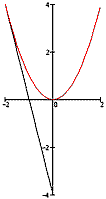[ Note: Terms related
to analyses
of a system of plane curves are given in orange.]
Historical
sketch of one curve . . . .
Notice the animated tangent to the parabola in the upper right hand
corner. The parabola is undoubtedly the most studied curve in the
history of mathematics. A treatise, Conic Sections,
written by Euclid (ca. 300 B.C.), has been
lost but is thought to have provided a foundation for Apollonius' first
four
books of the same name. Both the scholar and
student
can trace this work through the Alexandrian school. Hypatia (d.
415
A.D.), the first woman in the history of mathematics known by name, is
said
to have made the translation.
These manuscripts can then be traced to Western
Europe via Arab conquest, first through North Africa, and then into
Spain. Toledo, Cordova and Seville were outstanding centers of
learning from the 9th to the llth centuries.
Later, Galileo (1564 - 1642) discovered that a
cannonball follows a parabolic path. Scientists, monarchs and
military leaders immediately took great interest! The aiming of a
cannon became a function of measuring the precise angle of a
trajectory, the "throw weight" and its momentum. With these
experiments and especially the famous dropping of objects from the top
of the Leaning Tower of Pisa, Galileo revolutionized science. He
introduced the "scientific method" as a permanent contribution to
civilization. Later his heliocentric theory of the universe
almost cost him his life.
Descartes, in writing La
Géométrie (1637),
chose the parabola to illustrate his innovative analytic
geometry. At
this time in publishing history, all math figures were difficult to
create and to print.
In 1992, R. A. Marcus of the California Institute
of Technology won the Nobel Prize in Chemistry for his work showing
that parabolic reaction surfaces can be used to calculate how fast
electrons travel in molecules.
His most famous theoretical result, an inverted rate-energy parabola,
predicts electron transfer will slow down at very high reaction free
energies.
Millions of students in recent centuries will
remember the parabola as the introductory curve leading into study of
the Calculus.
|
|
|
An Informal
Glossary of Common Terms:
| Caustic: |
A caustic curve is the envelope of
light rays emitted from a point, after reflection or refraction by a
given curve.
The caustics are either catacaustic as a
result of reflection or diacaustic as a
result
of refraction. |
| Cusp: |
If a curve is traced by a moving
point, a cusp-point is one where the moving
point reverses its direction. See cusp-point
and curve
sketching. |
| Envelope: |
An envelope is a curve, or curves,
touching every member of a system of lines or curves.
See the illustration of an envelope and also the animation of
Neile's Parabola.
|
| Evolute: |
The envolute of a plane curve is
the locus of centers of curvature of another curve, and therefore
tangent to all its normals; so called because the other curve (called
the involute) can
be traced by the end of a string gradually being unwound from it.
Moreover, the evolute may also be throught of as the envelope of the
normals to the curve. The family of intersecting normals
on the interior
of a parabola form the evolute of the parabola and is
commonly
called a cissoid. Also, see the animation of
Neile's Parabola. |
Hermit Point:
|
Please see the
illustration under curve
sketching. |
| Involute: |
One may think of the involute as the inverse
operation of the evolute. Alfred Gray writes, "...the evolute is
related to the involute in the same way that differentiation is related
to indefinite integration."
Thus, the original parabola becomes the involute
of its evolute. See the example of an involute of a circle. |
| Node: |
Please see the
illustration under curve
sketching.
|
| Normal: |
The term "normal" has many usages in
mathematics. In curve tracing, a normal is the perpendicular to a
tangent of a curve drawn at the point of tangency. Also, see the animation of
Neile's Parabola.
|
Pedal
and its
Pole: |
A pedal curve represents
the locus of the feet of perpendiculars let fall from a given point to
tangent(s) on a given curve or curved surface. |
| Singularity: |
Please see the
illustrations under curve
sketching and the "hermit"
point.
|
|
|
Useful Links and Books
|
| http://www-history.mcs.st-and.ac.uk/history/Curves/Curves.html |
| http://mathworld.wolfram.com/PlaneCurve.html |
We recommend the following
books as having excellent, but varied information on curves and
surfaces.
Some of these texts are certain to be
in your library and all are available through interlibrary loan.
|
| Eves, Howard. AN INTRODUCTION
TO THE HISTORY OF MATHEMATICS, 6th ed., Saunders College
Publishing, Harcourt Brace Jovanovich, 1990. |
| Frost, Percival. An
Elementary Treatise on CURVE TRACING, 5th ed., Revised by R. J. T.
Bell, Chelsea Publishing Company, 1960. |
| Gibson, C. G. Elementary
Geometry of Algebraic Curves: An Undergraduate Introduction.
Cambridge University
Press, 1998. |
| Gray, Alfred. Modern
Differential Geometry of Curves and Surfaces with MATHEMATICA® ,2nd ed., CRC Press,
1998. |
| Hilton, Harold. Plane
Algebraic Curves, Oxford University Press, 1932. |
| Lawrence, J. D. A Catalog of
Special Plane Curves, Dover Publications, 1972. |
| Lockwood, E. H. A Book of
CURVES, Cambridge University Press, 1961. |
| Shikin, Eugene V. Handbook
and Atlas of CURVES, CRC Press, 1995. |
| Yates, Robert. CURVES AND
THEIR PROPERTIES, The National Council of Teachers of Mathematics,
1952. |
|
|
|


